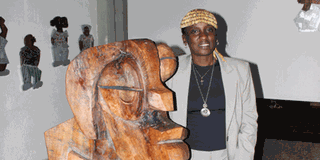Using Art to talk about HIV/AIDS

Nabulime observes that the art scene in Uganda is showing signs of growth. “It is growing as more artists are coming up, both self-taught and those taught. Art is gaining value and more artists are getting recognition.”
What you need to know:
Having been affected by HIV/Aids, Lilian Nabulime decided to do a PhD in sculpture so as to spread the message of the deadliness of the virus but to also give hope to those who suffer from it.
“Ssebo” is a sculpture, a big grotesque portrait with masculine forms. Its face has big expressive eyes, nose and mouth. The sculpture is made of geometrical angular and round forms. Ssebo is a sculpture that was made by Dr Lilian Mary Nabulime, one of Uganda’s leading female sculptors, a sculpture that reminds her of the patriarchal society we live in. Nabulime believes that men are dominant and usually take control of decisions. They give an impression of being fearless, aggressive, powerful and prestigious and yet it may not be the case. All these thoughts are personified in Ssebo. Sculpture is what Nabulime uses to put across her thoughts and feelings on various topics. One topic dear to her heart is HIV/Aids.
Nabulime handles the painful episode of living with HIV/Aids with sadness and humour at the same time. For a topic that is often taboo, her artwork is a means to discuss the scourge and enjoy the conversation with our everyday household items like a mortar and pestle, soap and baskets.
“My sculptures are simple, derived from household objects namely baskets, mirrors and soap. The idea is to encourage dialogue on HIV/Aids infections, fight taboos, culture and gender inequality because they propel HIV/Aids infections. It is also to fight stigma and denial and to encourage openness and care for those infected with HIV/Aids leading to acceptance, counselling and testing, and therefore leading to treatment. Care for one another will lead to less malicious infections to others,” she says.
According to Nabulime, artists have a role to play as society grapples with challenges like HIV/Aids: “The challenges of artists in fighting HIV/Aids vary according to the medium an artist uses. Graphics like posters, illustrations, drama, and music seem easy to use for HIV/Aids campaign organisations. Yet other mediums like sculptures, paintings and conceptual art have not been greatly exploited for fighting HIV/Aids.”
“Art is also a very powerful tool that can change people‘s attitudes regarding issues that affect them, thus empowering them, leading to change among themselves, socially or politically,” she notes.
Nabulime is one of the few female sculptors in Uganda. She currently works on a combination of wood and sheet metal, producing monumental sculptures. Carving tree stumps has become her trademark. Nabulime touches on taboo subjects and themes like male-female power relations in modern times, and race and disease eating up the African continent.
Complacency, gender inequality and poverty are the major challenges facing the HIV/Aids fight in Uganda, Nabulime observes.
“Because we have had HIV/Aids for over 25 years, people are tired of it and complacent, yet it is still viral. There is no cure yet. Because some people living with HIV/Aids are on Antiretroviral drugs and look good, others think it is like any other disease (no worries). Without fighting poverty we are wasting time on HIV/Aids campaigns. While doing my research, a woman told me that because of poverty, she goes into prostitution to get money to feed her children. ‘Hunger kills in a week but Aids kills you after years’, she argued.
“The posters or images on billboards warning on HIV are not scary as in the past. We should also fight taboos, culture and gender inequality because they propel HIV/Aids infections. We should fight stigma and denial. Openness and care for those infected with HIV/Aids leads to acceptance, counselling and testing leading to treatment thus less malicious infection to others,” she adds.
Nabulime therefore suggests that: “People need constant reminders on HIV/Aids awareness. Government officials and religious leaders should address HIV/Aids when they get a chance, at public and private gatherings. We can also fall back on the ABC strategy. Reduce poverty and educate people to be job creators and not seekers. Government needs to create and provide more jobs.”
Experience spurred her on
Nabulime decided to become an HIV/Aids campaigner after her close relatives died from the deadly disease. “I took on the HIV/Aids campaign through my sculptures after realising that I was affected by HIV/Aids. I am HIV negative and I have had close family members suffering and dying from HIV/Aids. HIV/Aids is a disease people can avoid if they are well informed. People do not want to talk publically about sex and HIV, yet in Uganda most of the infections are heterosexual thus, issues regarding HIV/Aids and sex are a taboo,” she said.
“Forgiving my husband when he tested HIV positive while I was negative was a real test of courage,” she says in the book Extraordinary: Significant Women of Uganda by Daudi Karungi.
“I did not develop my sculptures in Uganda. I had gone to the UK to pursue my PhD at the University of Newcastle (2007) and three days after, I went to the library and picked a book written by an American on women affected and infected with HIV/Aids in America. Reading that book made me realise that I too had been affected by HIV/Aids. That was the moment I decided to do my PhD on sculptures that can fight and warn on HIV/Aids,” she says.
“It was a turning point when I decided to research on sculptures that can stimulate discussions to educate people on HIV/Aids infections, seek counselling, treatment, and avoid infections, denial and stigmatising the infected and their families. Through my soap sculptures I was able to overcome the taboos regarding sex and HIV/Aids,” she adds.
Nabulime is currently on a Commonwealth Fellowship at Durham University (UK) and developing a manual guide that can help people use her sculpture/household objects for HIV/Aids awareness that will lead to less infection among the literates and non-literates and also address the various tribal languages.
“Through art you can express your feelings, and through art you can touch other people’s lives,” she says. “People don’t necessarily have to be educated. Once the work object is there and if it is attractive, it draws in people and they start asking questions. As they are asking, the information is being passed on and they are also giving you ideas,” she told the Indiana Daily Student yearbook.
Dealing with taboos
As to where she gets the courage to tackle taboo subjects in the Ugandan society, she argues: “Art is a wonderful media to portray controversial subjects or taboos. Powerful art does not need explanation. Art is non-verbal yet it draws people in, as they look, trying to grasp the messages. People tend to get offended when they hear offensive or taboo words but through art work you get away without being harassed.”
As to the subjects she tackles in her works, Nabulime says: “When the wood or logs are plain I think and plan by sketching or drawing a subject I wish to work on. The subject matter varies depending on what drives my mind, namely personal experiences, day to day life experiences, designs from clothes, children, beautiful or ugly faces and issues affecting society.”
Nabulime has observed that the usual channels of pushing for women emancipation through seminars, parliamentary debates and demonstrations have had significant shortfalls. She notes that women whose rights are being advocated for are never reached with the right messages, because of low literacy levels, especially in rural areas. Therefore, she and other female sculptors in Uganda have chosen art to silently push for women emancipation.
Women yet to rise
Nabulime observes that the art scene in Uganda is still dominated by men, with women facing a number of challenges denying them the opportunity to take up fine art as a profession. “Women have the same opportunities as men in art but they face challenges that hinder them, for example motherhood. Art takes a while to generate income so for a woman whose husband is not patient or is not interested in art he may discourage the wife to practice.”
Besides being commissioned by several organisations, Nabulime has published widely and held a number of local and international exhibitions around the world. She has also held fundraising HIV/Aids exhibitions in Uganda.
One of her recent exhibitions “Sculptural Figures Reflected on Daily Experiences” was held at the Makerere Art Gallery, Margaret Trowel School of Industrial Art from July 24 – August 24, 2011. A number of her works made of wood, metal, nails, terracotta/fired ceramic clay and textiles were displayed. The sculpture Ssebo, measuring 32x23x48 inches, was also displayed, as was her collaborative work with the American artist, Nicole Fall on the HIV/Aids virus made of wood, ceramic fired clay and backcloth.
Nabulime observes that the art scene in Uganda is showing signs of growth. “It is growing as more artists are coming up, both self-taught and those taught. Art is gaining value and more artists are getting recognition.”
Who is she?
Nabulime is currently a lecturer/sculpt at the Sculpture Department School of Industrial and Fine Art, Makerere University. She was the Acting Head of the same department between 1998-2001 and 2008-2009.
Nabulime holds a BA Fine Arts (1987), a Post Graduate Diploma in Education (1989), and Master of Arts Fine Arts (1993), all from Makerere University. She has a PhD from Newcastle University (UK). She has published a number of papers for international journals and authored books. She has also attended and presented papers in international forums.
In January-July 1997, she won a Commonwealth Fellowship under Commonwealth Scholarship Plan, Glasgow School of Art, in Scotland, where she taught first year students wood curving and participated in exhibitions.
In both 2008 and 2009 she received the Royal Overseas League ROLS Travel Fellowship to the UK. In 2009 she was a British Academy Visiting Fellow at Durham University in the UK.
Nabulime is a member of a number of professional bodies. She is an Associate Member of Developing Areas Research Network (DARN) based in the UK; International Museum of Women, USA; Uganda Artists Association; Rotary Club Kampala City Makerere; University Women Association Makerere University, among others.




